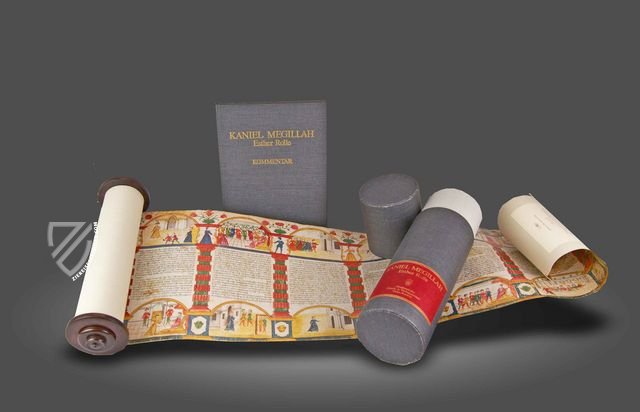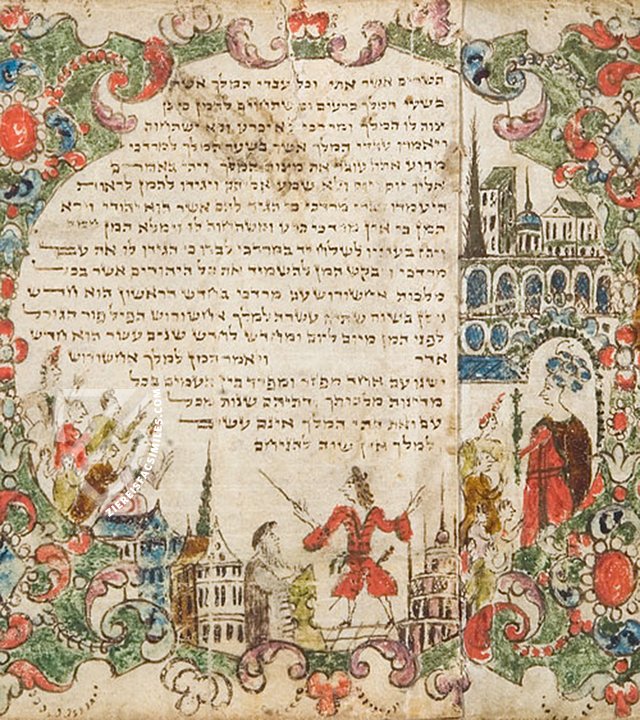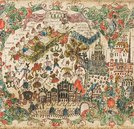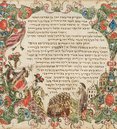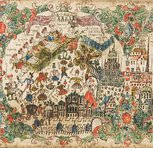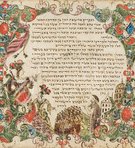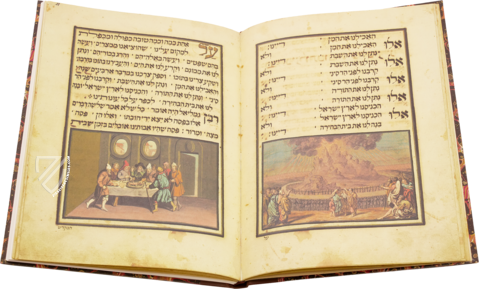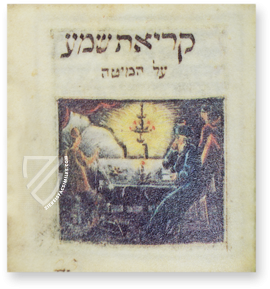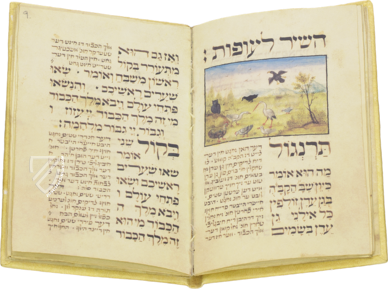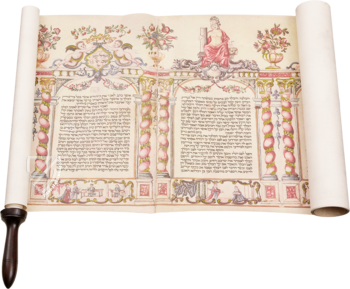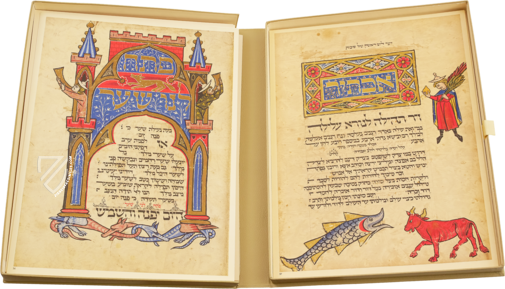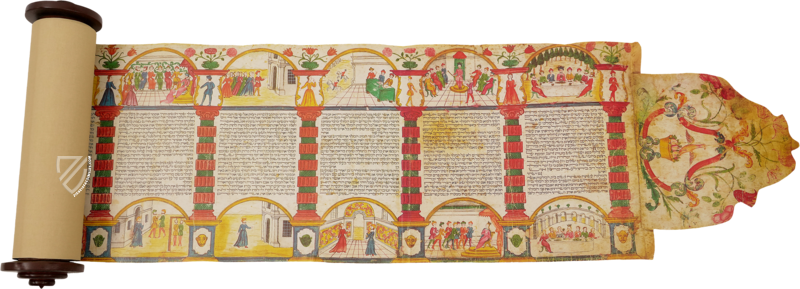Megillat Esther
(3,000€ - 7,000€)
The Megillat Esther belongs among the outstanding specimens of the so-called Esther-Rolls, a traditional artifact of Jewish culture. The biblical story of Queen Esther is read from these manuscript roles in the synagogue during the Feast of Purim. It was Esther who was able to free the Persian Jews from the rule of King Xerxes. In the Megillat Esther, this joyful and exciting history is illustrated in magnificent pictorial décor – a gorgeous special feature! This Megilla, which is found today in the private collection of the Gross family, is a treasure of Judaica that was probably made in Germany ca. 1700, and which is presented in a precious silver case!
Megillat Esther
The Megillat Esther belongs among the outstanding specimens of the so-called Esther-Rolls, a traditional artifact of Jewish culture. The biblical story of Queen Esther is read from these manuscript roles in the synagogue during the Feast of Purim. It was Esther who was able to free the Persian Jews from the rule of King Xerxes. In the Megillat Esther, this joyful and exciting history is illustrated in magnificent pictorial décor – a gorgeous special feature! The Megilla, which is found today in the private collection of the Gross family, is a treasure of Judaica that was probably made in Germany ca. 1700, and which is presented in a precious silver case!
The Joyful Feast of Purim
In the Bible’s Book of Esther – known both in the Christian as well as and in particular in the Jewish Bible – the story of the liberation of the Jews from evil is celebrated: the liberation of the Persian Jews from the rule of Xerxes. Queen Esther, because of her godly life, was able to thwart the plan of Haman to kill all the Jews on the same day. The Jewish Feast of Purim is celebrated on the occasion of this important event to this day. Purim, which usually falls around the middle of March and commemorates the events of the Book of Esther, is a high-spirited celebration!
An Illustrated Megilla
The manuscript roll of the Megillat Esther is an exceptional specimen of a so-called Megilla, a scroll, which is read from in a synagogue during the Feast of Purim. This Esther-scroll comes from the early 18th century. It was presumably made in Germany ca. 1700. Conclusions can be drawn about the temporal and spatial placement of the manuscript from the detailed architectural drawings and the costumes of the figures in the illumination. The two-sided scroll of the Megillat Esther measuring 10.8 x 168 cm is additionally, lavishly illuminated with 18 text plates, which is unusual. Figurative depictions illustrate the stories of the Book of Esther in the finest detail and thus make the Esther-Roll a particular jewel of Jewish culture!
An Outstanding Artifact
The Megillat Esther is stored today in the private collection of the Gross family in Tel Aviv, who have compiled an important collection of Judaica. The exceptional Esther-Roll is one of the most beautiful pieces of the collection! At the beginning of the 20th century, the Megilla was in Vienna, passing through the hands of various owners – e.g. the first Israeli ambassador in Vienna – coming to Israel and the United States and then finally back to its present location in Israel. A precious and artful silver case from the Gross Collection, made in Vienna in 1824 by Lorenz Pfalzer, serves simultaneously as protection and adornment for the precious manuscript roll of the Megillat Esther.
Codicology
- Size / Format
- 1 scroll / 168.0 × 10.8 cm
- Origin
- Germany
- Date
- Ca. 1700
- Epochs
- Style
- Illustrations
- The text pages are divided by sumptuous columns that lead into the opulently designed supporting program, which shows various figurative scenes
- Content
- Book of Esther for reading in a synagogue during the Feast of Purim
- Previous Owners
- Eliahu Sachar
Megillat Esther
Queen Esther before King Ahasuerus
After Mordecai discovers Haman’s plot against the Jews, he pleads with Esther to intercede, but she cannot present herself to the King unsummoned, which can be punished by death. She directs all the Jews to fast for three days and on the third day, facing mortal danger, she dresses herself in her royal regalia and goes to the royal court. When Ahasuerus see her, he is pleased and holds out his scepter toward her, indicating she will not be punished. She approaches and touches the tip of the scepter and invites him and Haman to a feast.
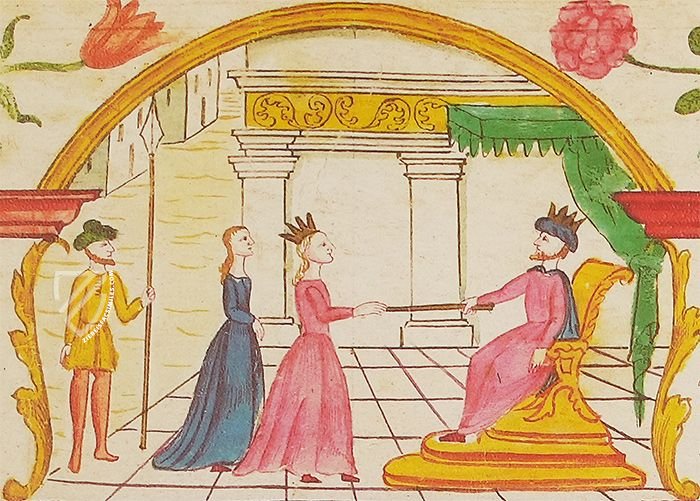
Megillat Esther
Mordecai Honored
Starting in the upper right-corner, we see the gallows that Mordecai has erected at his wife’s suggestion to hang Mordecai. Below, Ahasuerus cannot sleep; he orders the court records be read to him and is reminded how Mordecai stopped a plot to have him assassinated but was never honored for it. In the next scene, Haman arrives at court to ask for permission to hang Mordecai, but before he can, Ahasuerus asks him what should be done for the man that the King wishes to honor.
Thinking the honors are intended for himself, Haman say the man should be dressed in royal robes, crowned, and paraded through the streets on the King’s horse while a herald calls “This is what is done for the man the king delights to honor!” The scene below shows Mordecai receiving these honors as a humiliated Haman is forced to act as the herald and is depicted leading the procession and blowing a long horn.
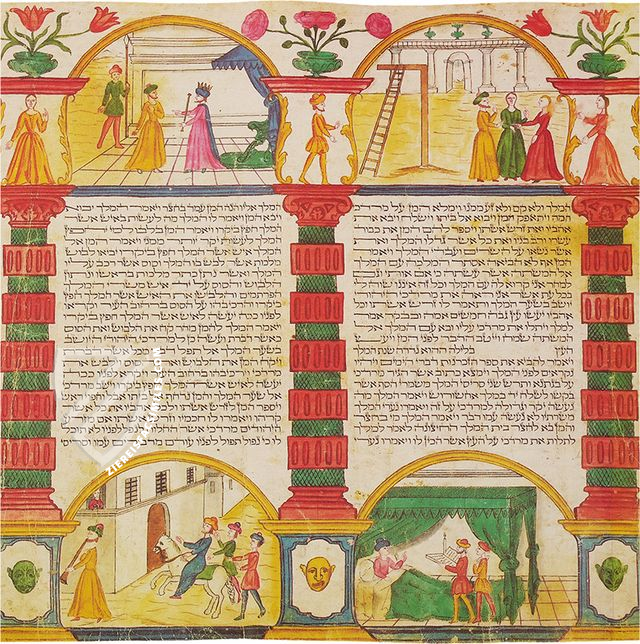
#1 Megillat Esther
Language: English
(3,000€ - 7,000€)
- Treatises / Secular Books
- Apocalypses / Beatus
- Astronomy / Astrology
- Bestiaries
- Bibles / Gospels
- Chronicles / History / Law
- Geography / Maps
- Saints' Lives
- Islam / Oriental
- Judaism / Hebrew
- Single Leaf Collections
- Leonardo da Vinci
- Literature / Poetry
- Liturgical Manuscripts
- Medicine / Botany / Alchemy
- Music
- Mythology / Prophecies
- Psalters
- Other Religious Books
- Games / Hunting
- Private Devotion Books
- Other Genres
- Afghanistan
- Armenia
- Austria
- Belgium
- Belize
- Bosnia and Herzegovina
- China
- Colombia
- Costa Rica
- Croatia
- Cyprus
- Czech Republic
- Denmark
- Egypt
- El Salvador
- Ethiopia
- France
- Germany
- Greece
- Guatemala
- Honduras
- Hungary
- India
- Iran
- Iraq
- Israel
- Italy
- Japan
- Jordan
- Kazakhstan
- Kyrgyzstan
- Lebanon
- Liechtenstein
- Luxembourg
- Mexico
- Morocco
- Netherlands
- Palestine
- Panama
- Peru
- Poland
- Portugal
- Romania
- Russia
- Serbia
- Spain
- Sri Lanka
- Sweden
- Switzerland
- Syria
- Tajikistan
- Turkey
- Turkmenistan
- Ukraine
- United Kingdom
- United States
- Uzbekistan
- Vatican City
- A. Oosthoek, van Holkema & Warendorf
- Aboca Museum
- Ajuntament de Valencia
- Akademie Verlag
- Akademische Druck- u. Verlagsanstalt (ADEVA)
- Aldo Ausilio Editore - Bottega d’Erasmo
- Alecto Historical Editions
- Alkuin Verlag
- Almqvist & Wiksell
- Amilcare Pizzi
- Andreas & Andreas Verlagsbuchhandlung
- Archa 90
- Archiv Verlag
- Archivi Edizioni
- Arnold Verlag
- ARS
- Ars Magna
- ArtCodex
- AyN Ediciones
- Azimuth Editions
- Badenia Verlag
- Bärenreiter-Verlag
- Belser Verlag
- Belser Verlag / WK Wertkontor
- Benziger Verlag
- Bernardinum Wydawnictwo
- BiblioGemma
- Biblioteca Apostolica Vaticana (Vaticanstadt, Vaticanstadt)
- Bibliotheca Palatina Faksimile Verlag
- Bibliotheca Rara
- Boydell & Brewer
- Bramante Edizioni
- Bredius Genootschap
- Brepols Publishers
- British Library
- C. Weckesser
- Caixa Catalunya
- Canesi
- CAPSA, Ars Scriptoria
- Caratzas Brothers, Publishers
- Carus Verlag
- Casamassima Libri
- Centrum Cartographie Verlag GmbH
- Chavane Verlag
- Christian Brandstätter Verlag
- Circulo Cientifico
- Club Bibliófilo Versol
- Club du Livre
- CM Editores
- Collegium Graphicum
- Collezione Apocrifa Da Vinci
- Comissão Nacional para as Comemorações dos Descobrimentos Portugueses
- Coron Verlag
- Corvina
- CTHS
- D. S. Brewer
- Damon
- De Agostini/UTET
- De Nederlandsche Boekhandel
- De Schutter
- Deuschle & Stemmle
- Deutscher Verlag für Kunstwissenschaft
- DIAMM
- Droz
- E. Schreiber Graphische Kunstanstalten
- Ediciones Boreal
- Ediciones Grial
- Ediclube
- Edições Inapa
- Edilan
- Editalia
- Edition Deuschle
- Edition Georg Popp
- Edition Leipzig
- Edition Libri Illustri
- Editiones Reales Sitios S. L.
- Éditions de l'Oiseau Lyre
- Editions Medicina Rara
- Editorial Casariego
- Editorial Mintzoa
- Editrice Antenore
- Editrice Velar
- Edizioni Edison
- Egeria, S.L.
- Eikon Editores
- Electa
- Emery Walker Limited
- Enciclopèdia Catalana
- Eos-Verlag
- Ephesus Publishing
- Ernst Battenberg
- Eugrammia Press
- Extraordinary Editions
- Fackelverlag
- Facsimila Art & Edition
- Facsimile Editions Ltd.
- Facsimilia Art & Edition Ebert KG
- Faksimile Verlag
- Feuermann Verlag
- Folger Shakespeare Library
- Franco Cosimo Panini Editore
- Friedrich Wittig Verlag
- Fundación Hullera Vasco-Leonesa
- G. Braziller
- Gabriele Mazzotta Editore
- Gebr. Mann Verlag
- Gesellschaft für graphische Industrie
- Getty Research Institute
- Giovanni Domenico de Rossi
- Giunti Editore
- Graffiti
- Grafica European Center of Fine Arts
- Guido Pressler
- Guillermo Blazquez
- Gustav Kiepenheuer
- H. N. Abrams
- Harrassowitz
- Harvard University Press
- Helikon
- Hendrickson Publishers
- Henning Oppermann
- Herder Verlag
- Hes & De Graaf Publishers
- Hoepli
- Holbein-Verlag
- Houghton Library
- Hugo Schmidt Verlag
- Idion Verlag
- Il Bulino, edizioni d'arte
- ILte
- Imago
- Insel Verlag
- Insel-Verlag Anton Kippenberger
- Instituto de Estudios Altoaragoneses
- Instituto Nacional de Antropología e Historia
- Introligatornia Budnik Jerzy
- Istituto dell'Enciclopedia Italiana - Treccani
- Istituto Ellenico di Studi Bizantini e Postbizantini
- Istituto Geografico De Agostini
- Istituto Poligrafico e Zecca dello Stato
- Italarte Art Establishments
- Jan Thorbecke Verlag
- Johnson Reprint Corporation
- Josef Stocker
- Josef Stocker-Schmid
- Jugoslavija
- Karl W. Hiersemann
- Kasper Straube
- Kaydeda Ediciones
- Kindler Verlag / Coron Verlag
- Kodansha International Ltd.
- Konrad Kölbl Verlag
- Kurt Wolff Verlag
- La Liberia dello Stato
- La Linea Editrice
- La Meta Editore
- Lambert Schneider
- Landeskreditbank Baden-Württemberg
- Leo S. Olschki
- Les Incunables
- Liber Artis
- Library of Congress
- Libreria Musicale Italiana
- Lichtdruck
- Lito Immagine Editore
- Lumen Artis
- Lund Humphries
- M. Moleiro Editor
- Maison des Sciences de l'homme et de la société de Poitiers
- Manuscriptum
- Martinus Nijhoff
- Maruzen-Yushodo Co. Ltd.
- MASA
- Massada Publishers
- McGraw-Hill
- Metropolitan Museum of Art
- Militos
- Millennium Liber
- Müller & Schindler
- Nahar - Stavit
- Nahar and Steimatzky
- National Library of Wales
- Neri Pozza
- Nova Charta
- Oceanum Verlag
- Odeon
- Orbis Mediaevalis
- Orbis Pictus
- Österreichische Staatsdruckerei
- Oxford University Press
- Pageant Books
- Parzellers Buchverlag
- Patrimonio Ediciones
- Pattloch Verlag
- PIAF
- Pieper Verlag
- Plon-Nourrit et cie
- Poligrafiche Bolis
- Presses Universitaires de Strasbourg
- Prestel Verlag
- Princeton University Press
- Prisma Verlag
- Priuli & Verlucca, editori
- Pro Sport Verlag
- Propyläen Verlag
- Pytheas Books
- Quaternio Verlag Luzern
- Reales Sitios
- Recht-Verlag
- Reichert Verlag
- Reichsdruckerei
- Reprint Verlag
- Riehn & Reusch
- Roberto Vattori Editore
- Rosenkilde and Bagger
- Roxburghe Club
- Salerno Editrice
- Saltellus Press
- Sandoz
- Sarajevo Svjetlost
- Schöck ArtPrint Kft.
- Schulsinger Brothers
- Scolar Press
- Scrinium
- Scripta Maneant
- Scriptorium
- Shazar
- Siloé, arte y bibliofilia
- SISMEL - Edizioni del Galluzzo
- Sociedad Mexicana de Antropología
- Société des Bibliophiles & Iconophiles de Belgique
- Soncin Publishing
- Sorli Ediciones
- Stainer and Bell
- Studer
- Styria Verlag
- Sumptibus Pragopress
- Szegedi Tudomànyegyetem
- Taberna Libraria
- Tarshish Books
- Taschen
- Tempus Libri
- Testimonio Compañía Editorial
- Thames and Hudson
- The Clear Vue Publishing Partnership Limited
- The Facsimile Codex
- The Folio Society
- The Marquess of Normanby
- The Richard III and Yorkist History Trust
- Tip.Le.Co
- TouchArt
- TREC Publishing House
- TRI Publishing Co.
- Trident Editore
- Tuliba Collection
- Typis Regiae Officinae Polygraphicae
- Union Verlag Berlin
- Universidad de Granada
- University of California Press
- University of Chicago Press
- Urs Graf
- Vallecchi
- Van Wijnen
- VCH, Acta Humaniora
- VDI Verlag
- VEB Deutscher Verlag für Musik
- Verlag Anton Pustet / Andreas Verlag
- Verlag Bibliophile Drucke Josef Stocker
- Verlag der Münchner Drucke
- Verlag für Regionalgeschichte
- Verlag Styria
- Vicent Garcia Editores
- W. Turnowski Ltd.
- W. Turnowsky
- Waanders Printers
- Wiener Mechitharisten-Congregation (Wien, Österreich)
- Wissenschaftliche Buchgesellschaft
- Wissenschaftliche Verlagsgesellschaft
- Wydawnictwo Dolnoslaskie
- Xuntanza Editorial
- Zakład Narodowy
- Zollikofer AG

